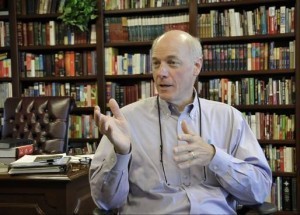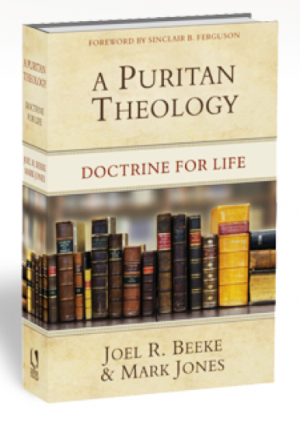Justin Taylor's Blog, page 186
October 17, 2012
My Favorite Part of the Debate Last Night
CROWLEY: Lorraine Osorio has a question for you about a topic we have not…
ROMNEY: Is it Loraina?
QUESTION: Lorraine.
ROMNEY: Lorraine?
QUESTION: Yes, Lorraine.
ROMNEY: Lorraine.
[Asks question]
ROMNEY: Thank you. Lorraine? Did I get that right? Good. . . . [Answers question.]
OBAMA: Was — Lorranna — Lorraine — we are a nation of immigrants.
October 16, 2012
What’s a Christian Business Owner Supposed to Do?
 Mark Taylor (no relation, except first in Adam and now in Christ) is president of Tyndale House Publishers in Carol Stream, IL. He recently wrote in World Magazine about the penalties the federal government is seeking to impose on Tyndale in violation of their freedom of religion and right to act in accord with their biblically informed conscience:
Mark Taylor (no relation, except first in Adam and now in Christ) is president of Tyndale House Publishers in Carol Stream, IL. He recently wrote in World Magazine about the penalties the federal government is seeking to impose on Tyndale in violation of their freedom of religion and right to act in accord with their biblically informed conscience:
My parents founded Tyndale House Publishers 50 years ago as a Christian publishing company. From the very beginning we have published Bibles, and we also publish a wide range of other Christian books. Our corporate purpose is “to minister to the spiritual needs of people, primarily through literature consistent with biblical principles.”
I’ve always thought—in a theoretical way—that I might someday face a situation where the government was asking or telling me to do something that was counter to God’s law as I understood it. If such a situation arose, I hoped I would have the backbone to stand tall and disobey the government mandate. Well, that day seems to have come.
Later in the piece he enumerates the costs to his company:
The HHS mandate became effective for Tyndale House on Oct. 1. If we did not comply, we would be subject to fines of up to $100 per day per employee. We have 260 employees, so the fines could be $26,000 per day. That’s $780,000 per month, and $9.36 million per year—all because our moral and religious compass says that it is wrong for us to provide abortifacient substances or devices under our employee health plan. The federal government is telling us to violate our conscience or pay fines that would put us out of business.
You can read the whole thing here.
Prayers against this ruling, it seems to me, are appropriate, in line with 1 Timothy 2:1-2: “I urge that supplications, prayers, intercessions, and thanksgivings be made for all people, for kings and all who are in high positions, that we may lead a peaceful and quiet life, godly and dignified in every way.” The HHS mandate prevents Christian companies from fulfilling their vocations in godly ways that respect human life and dignity, therefore we should pray that God would move in the hearts of those in high positions so that the government would fulfill its primary calling: the practice and promotion of justice.
October 15, 2012
The 3 Deadly Corrupting Powers of the Ring
 Ralph Wood, author of The Gospel According to Tolkien: Visions of the Kingdom in Middle-earth, identifies the three corrupting features associated with the ring:
Ralph Wood, author of The Gospel According to Tolkien: Visions of the Kingdom in Middle-earth, identifies the three corrupting features associated with the ring:
(1) Power to overcome death—thus granting unending physical life.
Perhaps the chief idolatry of our time, the worship of health and longevity, whereas the naturally immortal elves, while understanding the full cosmic process, also envy men for their great blessing of death.
(2) Power to become invisible—thus granting magical disappearance.
Hence the ability to acquire goods without effort, whereas everything worth having is meant to be acquired slowly, not quickly and easily. Yet evil has a shadowy, unreal existence, lacking any creative power, able only to pervert our virtues and to destroy the good. It has no imaginative sympathy, only the flat, unpenetrating eye of Sauron.
(3) Power to coerce the will of others—making evil horribly addictive because it is not merely seductive but also bullying—as when Frodo’s will is finally overwhelmed in the end.
This is exactly the doctrine of Original Sin as a one-way street that cannot be cured by our own effort, but that can be healed only by a transcendent and redemptive power beyond it.
For those who are interested, the latest Christian contribution to the literature of Tolkieniana is Louis Markos’ On the Shoulders of Hobbits: The Road to Virtue with Tolkien and Lewis.
50 Essential Strategies for Every Writer
 The list from Roy Peter Clark’s book, Writing Tools: 50 Essential Strategies for Every Writer:
The list from Roy Peter Clark’s book, Writing Tools: 50 Essential Strategies for Every Writer:
I. Nuts and Bolts
1. Begin sentences with subjects and verbs.
Make meaning early, then let weaker elements branch to the right.
2. Order words for emphasis.
Place strong words at the beginning and at the end.
3. Activate your verbs.
Strong verbs create action, save words, and reveal the players.
4. Be passive-aggressive.
Use passive verbs to showcase the “victim” of action.
5. Watch those adverbs.
Use them to change the meaning of the verb.
6. Take it easy on the -ings.
Prefer the simple present or past.
7. Fear not the long sentence.
Take the reader on a journey of language and meaning.
8. Establish a pattern, then give it a twist.
Build parallel constructions, but cut across the grain.
9. Let punctuation control pace and space.
Learn the rules, but realize you have more options than you think.
10. Cut big, then small.
Prune the big limbs, then shake out the dead leaves.
II. Special Effects
11. Prefer the simple over the technical.
Use shorter words, sentences, and paragraphs at points of complexity.
12. Give key words their space.
Do not repeat a distinctive word unless you intend a specific effect.
13. Play with words, even in serious stories.
Choose words the average writer avoids but the average reader understands.
14. Get the name of the dog.
Dig for the concrete and specific, details that appeal to the senses.
15. Pay attention to names.
Interesting names attract the writer—and the reader.
16. Seek original images.
Reject cliches and first-level creativity.
17. Riff on the creative language of others.
Make word lists, free-associate, be surprised by language.
18. Set the pace with sentence length.
Vary sentences to influence the reader’s speed.
19. Vary the lengths of paragraphs.
Go short or long — or make a “turn”- to match your intent.
20. Choose the number of elements with a purpose in mind.
One, two, three, or four: Each sends a secret message to the reader.
21. Know when to back off and when to show off.
When the topic is most serious, understate; when least serious, exaggerate.
22. Climb up and down the ladder of abstraction.
Learn when to show, when to tell, and when to do both.
23. Tune your voice.
Read drafts aloud.
III. Blueprints
24. Work from a plan.
Index the big parts of your work.
25. Learn the difference between reports and stories.
Use one to render information, the other to render experience.
26. Use dialogue as a form of action.
Dialogue advances narrative; quotes delay it.
27. Reveal traits of character.
Show characteristics through scenes, details, and dialogue.
28. Put odd and interesting things next to each other.
Help the reader learn from contrast.
29. Foreshadow dramatic events or powerful conclusions.
Plant important clues early.
30. To generate suspense, use internal cliffhangers.
To propel readers, make them wait.
31. Build your work around a key question.
Good stories need an engine, a question the action answers for the reader.
32. Place gold coins along the path.
Reward the reader with high points, especially in the middle.
33. Repeat, repeat, repeat.
Purposeful repetition links the parts.
34. Write from different cinematic angles.
Turn your notebook into a “camera.”
35. Report and write for scenes.
Then align them in a meaningful sequence.
36. Mix narrative modes.
Combine story forms using the “broken line.”
37. In short pieces of writing, don’t waste a syllable.
Shape shorter works with wit and polish.
38. Prefer archetypes to stereotypes.
Use subtle symbols, not crashing cymbals.
39. Write toward an ending.
Help readers close the circle of meaning.
IV. Useful Habits
40. Draft a mission statement for your work.
To sharpen your learning, write about your writing.
41. Turn procrastination into rehearsal.
Plan and write it first in your head.
42. Do your homework well in advance.
Prepare for the expected — and unexpected.
43. Read for both form and content.
Examine the machinery beneath the text.
44. Save string.
For big projects, save scraps others would toss.
45. Break long projects into parts.
Then assemble the pieces into something whole.
46. Take interest in all crafts that support your work.
To do your best, help others do their best.
47. Recruit your own support group.
Create a corps of helpers for feedback.
48. Limit self-criticism in early drafts.
Turn it loose during revision.
49. Learn from your critics.
Tolerate even unreasonable criticism.
50. Own the tools of your craft.
Build a writing workbench to store your tools.
Jesus: Sorrowful but Always Rejoicing
Donald Macleod:
Much has been made of the fact that Jesus is never said to have smiled or laughed. Linked to the description of the Servant as a ‘man of sorrows and acquainted with grieft’ it has furnished a basis for the idea that Jesus’ life was unremittingly joyless and stressful.But this is a serious over-simplification.
Apart from all else, a joyless life would have been a sinful life.
Would Jesus have been guilty of the anxiety he forbade in others (Matthew 6:25)?
Would he have fallen short of Paul’s attainment as one who had learned to be content whatever the circumstances (Phil 4:11)?
Or of the precept to rejoice always (Phil 4:4)?
Could he have been filled with the Spirit and yet not have known the Spirit’s joy (Gal 5:22)?
Could he have given rest and relief to others (Matt 11:28) while remaining depressed and disconsolate himself?
. . . There are clear and specific statements in the New Testament to the effect that Jesus experienced deep, habitual joy.
In Luke 10:21, for example, he is described as ‘full of joy through the Holy Spirit’ (the verb used is ēgalliasato, from agalliaomai, to ‘exult or be overjoyed’).
In John 15:11 he refers to his own joy: ‘I have told you this so that my joy may be in you and that your joy may be complete.’ This clearly implies that the joy Jesus shares with his disciples is, in the first instance, his own. The immediate context makes plan that it was based on his sense of the Father’s love and approbation, and, beyond that, on his obedience to the Father’s commands. There is a similar reference in John 17:13, ‘I am coming to you now, but I say these things while I am still in the world, so that they may have the full measure of my joy within them.’
. . . He rejoiced, doubtless, in the being of his Father, meditating on him as an object of wonder and admiration; in his Father’s love, approbation and constant help and presence; in the beauties and glories of his Father’s creation; in doing his Father’s will, promoting his glory and saving his people; in the friendship, company, and conversation of those the Father had given to be with him; and in anticipating his return to the glory he had with the Father ‘before the world began’ (Jn. 17:5).
Such joy was an indispensable element in the psychology of his obedience. He served not as a slave but as a Son.
—Donald Macleod, The Person of Christ, Contours of Christian Theology, ed. Gerald Bray (Downers Grove, IL: IVP, 1998), p. 171.
October 13, 2012
Arguments for and against Images of the Incarnate Christ
From lecture outlines that were expanded into The Doctrine of the Christian Life, John Frame identifies five arguments against picturing Jesus:
Since God may not be pictured, and Jesus is God, Jesus may not be pictured either.
Iconoclasts in the Eastern Church argued that those who venerated images of Christ were circumscribing Jesus’ divine nature. To worship the picture would involve the assumption that his divine nature is limited, circumscribed by the human nature and is therefore picturable. Or it would imply that the human nature alone is pictured and thus is separable from the divine nature.
Some have argued that since we don’t know what Jesus looked like, any picture will be a lie.
Some take the second commandment to exclude any representations of deity.
The danger of idolatry, at least, is always present when pictures of Jesus are used for any purpose.
Frame’s response to argument 1:
As we have seen, Scripture does not teach purely and simply that God cannot be pictured.
But even if God in himself were in every sense unpicturable, it is clear that Christ, God incarnate, was picturable. He could be seen, felt, touched, as well as heard. His face could be held in memory (and there is surely no suggestion in Scripture that such mental images were sinful! On the contrary, recall the emphasis upon the eyewitness character of the apostolic testimony.) To deny this is docetism, pure and simple. In this respect, clearly, the Old and New Covenants are sharply different. At the establishment of the Old Covenant, there was emphatically no form (Deuteronomy 4:15). At the establishment of the New, there emphatically was (I John 1:1ff., etc.).
Response to argument 2:
The relation between the two natures of Christ is, of course, a difficult matter at any point in theology. I would argue, however, that Jesus himself is, in both natures, in his person, image of God. In him, deity was in one sense “circumscribed,” for all its fullness dwelt in him; though in another sense, God was active beyond the body of Jesus. To picture Jesus is to picture a divine person, not one “nature” or other. To venerate such a picture, I believe, would be wrong for reasons already adduced. I do not, however, think that an adequate argument has been given against pedagogical use of such pictures.
Response to argument 3:
As we’ve said earlier, a picture does not become a “lie” simply by being non-exhaustive. And, in fact, we do know something about Jesus’ looks: He was male, Semitic, in middle life, was known to wear a robe, etc. . . .
Response to argument 4:
As we have seen, the second commandment doesn’t forbid all images of God, only those intended for use in worship, as we earlier discussed it.
Reply to argument 5:
True.
October 12, 2012
10 Reasons Why God Allows Suffering
Jared Wilson, in Gospel Deeps, writes that “while we may not be satisfied with what God has revealed about his purposes in suffering, we cannot justifiably say he has not revealed anything about his purposes in suffering. We may not have the answer we are laboring for, but we do have a wealth of answers that lie in the same field.”
Here’s an outline of ten reasons he identifies in God’s Word:
To remind us that the world is broken and groans for redemption [Rom. 8:20-23].
To do justice in response to Adam’s (and our) sin.
To remind us of the severity of the impact of Adam’s (and our) sin.
To keep us dependent on God [Heb. 12:6-7].
So that we will long more for heaven and less for the world.
To make us more like Christ, the suffering servant [Rom. 8:29; 2 Cor. 1:5, 4:11].
To awaken the lost to their need for God [Ps. 119:67, 71].
To make the bliss of heaven more sweet [Rom. 8:18; 1 Pet. 4:13; Ps. 126:5; Isa. 61:3].
So that Christ will get the glory in being our strength [John 9:3; 2 Cor. 4:7].
And so that, thereby, others see that he is our treasure, and not ourselves [2 Cor. 4:8-9].
See Jared C. Wilson, Gospel Deeps: Reveling in the Excellencies of Jesus (Wheaton, IL: Crossway, 2012), pp. 114-120 for an elaboration of each point.
Mr. Vice President, That Is Not a Fact
 Last night in the debate Vice President Biden said the following:
Last night in the debate Vice President Biden said the following:
With regard to the assault on the Catholic Church, let me make it absolutely clear. No religious institution—Catholic or otherwise, including Catholic social services, Georgetown hospital, Mercy hospital, any hospital—none has to either refer contraception, none has to pay for contraception, none has to be a vehicle to get contraception in any insurance policy they provide. That is a fact. That is a fact.
The United States’ Conference of Catholic Bishops rebuts this claim:
This is not a fact.
The HHS mandate contains a narrow, four-part exemption for certain “religious employers.” That exemption was made final in February and does not extend to “Catholic social services, Georgetown hospital, Mercy hospital, any hospital,” or any other religious charity that offers its services to all, regardless of the faith of those served.
HHS has proposed an additional “accommodation” for religious organizations like these, which HHS itself describes as “non-exempt.” That proposal does not even potentially relieve these organizations from the obligation “to pay for contraception” and “to be a vehicle to get contraception.” They will have to serve as a vehicle, because they will still be forced to provide their employees with health coverage, and that coverage will still have to include sterilization, contraception, and abortifacients. They will have to pay for these things, because the premiums that the organizations (and their employees) are required to pay will still be applied, along with other funds, to cover the cost of these drugs and surgeries.
USCCB continues to urge HHS, in the strongest possible terms, actually to eliminate the various infringements on religious freedom imposed by the mandate.
For more details, please see USCCB’s regulatory comments filed on May 15 regarding the proposed “accommodation.”
Over 100 plaintiffs—Catholic and Protestant—have now joined legal challenges to Obamacare’s anti-conscience mandate. Here’s the go-to page for updates and information on this unconstitutional mandate.
HT: Leroy Huizenga
An Interview with Marsden and Noll on the Idea of America as a Christian Nation
Historians Mark Noll and George Marsden sit down with Skot Welch (of Compass Cinema at Calvin College) for a half-hour conversation on whether the United States was founded as a Christian nation.
October 11, 2012
A Landmark Book: The First Puritan Systematic Theology
 For one week WTS Books is selling the massive new book A Puritan Theology: Doctrine for Life by Joel Beeke and Mark Jones for 50% off ($30 instead of $60).
For one week WTS Books is selling the massive new book A Puritan Theology: Doctrine for Life by Joel Beeke and Mark Jones for 50% off ($30 instead of $60).
You can read online for free the foreword by Sinclair Ferguson, the table of contents, and a sample chapter on “The Puritans on Union with Christ,
Justification, and Regeneration.”
“[These] one thousand pages and more than half a million words . . . constitute the largest and most comprehensive exposition to date on the theology of the English Puritans. It is a remarkable achievement. . . . There are too many outstanding features of this volume to list them adequately. The sheer range of theology covered—each locus in the theological encyclopedia is touched on—is breathtaking; the focus of attention on some of the most significant thinkers, preachers, and writers (who were men who, to a remarkable degree, combined all three) is profoundly impressive. These pages are not replete with complexities and obscurities. Nor are they light reading. . . . But if you share the concern of the Puritans to think biblically in order to live to the glory of God, these pages will prove to be a goldmine.”
—From the foreword by Sinclair Ferguson
“Without a doubt, this will be an indispensable guidebook to Puritan thought and practice for years to come.”
—Michael A. G. Haykin
“For more than half a century primary research on Puritan theologians and their teaching has been in full swing. Here now is a massive compendium of the findings, digested into sixty lively chapters. The authors’ expository skill will keep readers on their toes, and the Puritans’ own concern for godly living, which runs through everything, will send readers to their knees. This is a landmark book in every way.”
—J. I. Packer
“Joel Beeke’s and Mark Jones’s work marks a major milestone in the study of Puritan and early modern Reformed theology, setting forth in modern scholarly essays an examination of a full body of seventeenth-century divinity. The work evidences a significant understanding of the primary texts and an excellent grasp of the secondary literature, both providing a sound introduction to Puritan theology and setting aside the myths of a rigid, rationalistic, monolithic system of thought divorced from Christian life. Perhaps the most consistent and unifying theme in the book is the profound connection between faith and practice that, for the Puritans and other early modern Reformed, grounded the exposition of all doctrine. A Puritan Theology: Doctrine for Life will provide a starting point for further study of Puritan thought for years to come.”
—Richard A. Muller
“The Puritans are undoubtedly one of the most significant sources for theology that is both doctrinal and practical in equal measure. This massive volume by Joel Beeke and Mark Jones provides the reader with a comprehensive introduction to Puritan thought. It is a notable work of historical-theological synthesis and a book to which I will be returning again and again, both for scholarly reference and personal devotion. Simply an amazing achievement.”
—Carl R. Trueman
“There are great modern editions of many Puritan classics, anthologies collecting their quotes on various subjects, and myriad studies of the movement. So it’s a little surprising that a Puritan systematic theology like this one has never been written. I’m just glad that it has been, and by two scholar-pastors whose familiarity with the primary and secondary sources is unsurpassed. I couldn’t put it down and will return to it again and again. It is an ambitious undertaking, but the authors’ pain is our gain. This will be an enduring reference work as well as devotional resource.”
—Michael Horton
Justin Taylor's Blog
- Justin Taylor's profile
- 44 followers



